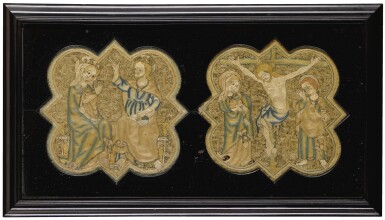Spetchley - Property from the Berkeley Collection
Spetchley - Property from the Berkeley Collection

TWO MEDIEVAL OPUS ANGLICANUM EMBROIDERED AND METAL-THREAD BURSE PANELS, ENGLISH, CIRCA 1320-1330
Auction Closed
December 11, 04:05 PM GMT
Estimate
20,000 - 30,000 GBP
Lot Details
Description
TWO MEDIEVAL OPUS ANGLICANUM EMBROIDERED AND METAL-THREAD BURSE PANELS, ENGLISH, CIRCA 1320-1330
of barbed quatrefoil format, finely worked in silk and metal-thread, one worked with the Crucifixion, with Christ flanked by the Virgin and St. John, the other with the Coronation of the Virgin, on a ground of complex gold embroidery with intricate pattern incorporating lions, each motif 25cm by 26cm, mounted together in a glazed frame
Glazed Frame: 37cm by 66cm; 1ft. 2in., 2ft. 1in.
‘Spetchley Park -I. Worcestershire, The Seat of Mr. R. V. Berkeley', Country Life, 8 July 1916, p. 45, illustrated in the Drawing Room
David Sylvester, ‘Through the Eye of a Needle’, Sunday Times Magazine, 22 December 1963, illustrated
English Medieval Embroidery 'Opus Anglicanum', Edited by Clare Brown, Glyn Davies, M.A. Michael and Michaela Zöschg, Victoria & Albert Museum, London, 1 October 2016-5 February 2017, Exhibition Catalogue, New Haven and London, 2016, No. 40, Burse, England, 1320-1330 (Victoria and Albert Museum London, mus. no. T.62-1936), pp.181-186
These quintessentially English embroidered 'opus anglicanum', complete quatre-foil motifs are not from a large ecclesiastical vestment, such as a processional cloak (Cope) or chasuble worn during Mass, in which they would have been included in a large composition incorporating various saints and Biblical scenes. An example of a Cope with incorporation of these two similar compositions, is the Syon Cope, England, 1310-20, originally with the Bridgettine Nuns of Syon Abbey, Isleworth, now in the Victoria & Albert Museum, London (Museum. No. T.83-1864). These particular motifs are most likely to have been the main part of a burse, which is a flat purse, used as a container for the corporal, the cloth on which the chalice and paten are placed during the Mass. The quatre-foil motif would be placed on each side of a rectangular panel, and originally folded over.
There is a rare example of an English Burse, circa 1320-1330, in the Victoria and Albert Museum, London (mus. no. T.62-1936), which has the same Biblical scenes depicted, with virtually the same compositional arrangement in the barbed quatre-foil motifs as depicted in the presently offered pieces. The detailing of the clothing and the figural positions have slight variations. The cited example is against the background rectangular panel of the now open and flat Burse. Other burses depicting these scenes which allude to Christ's sacrifice and his glory in heaven, and therefore a suitable choice for burses, are recorded in the 13th century inventories of St. Paul's Cathedral, Canterbury, Exeter and the Vatican.
